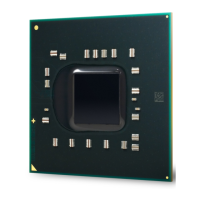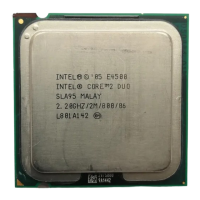Datasheet
31
Electrical Specifications
1. Refer to Chapter 4 for signal descriptions and termination requirements.
2. In processor systems where there is no debug port implemented on the system board,
these signals are used to support a debug port interposer. In systems with the debug port
implemented on the system board, these signals are no connects.
3. BPM[2:1]# and PRDY# are AGTL+ output-only signals.
4. PROCHOT# signal type is open drain output and CMOS input.
5. On-die termination differs from other AGTL+ signals.
3.8 CMOS Signals
CMOS input signals are shown in Tabl e 4. Legacy output FERR#, IERR# and other non-
AGTL+ signals (THERMTRIP# and PROCHOT#) use Open Drain output buffers. These
signals do not have setup or hold time specifications in relation to BCLK[1:0]. However,
all of the CMOS signals are required to be asserted for more than four BCLKs for the
processor to recognize them. See Section 3.10 for the DC specifications for the CMOS
signal groups.
3.9 Maximum Ratings
Tab le 5 specifies absolute maximum and minimum ratings only, which lie outside the
functional limits of the processor. Only within specified operation limits, can
functionality and long-term reliability be expected.
At conditions outside functional operation condition limits, but within absolute
maximum and minimum ratings, neither functionality nor long-term reliability can be
expected. If a device is returned to conditions within functional operation limits after
having been subjected to conditions outside these limits, but within the absolute
maximum and minimum ratings, the device may be functional, but with its lifetime
degraded depending on exposure to conditions exceeding the functional operation
condition limits.
At conditions exceeding absolute maximum and minimum ratings, neither functionality
nor long-term reliability can be expected. Moreover, if a device is subjected to these
conditions for any length of time then, when returned to conditions within the
functional operating condition limits, it will either not function, or its reliability will be
severely degraded.
Caution: Although the processor contains protective circuitry to resist damage from static
electric discharge, precautions should always be taken to avoid high static voltages or
electric fields.
NOTES:
1. For functional operation, all processor electrical, signal quality, mechanical and thermal
specifications must be satisfied.
Table 5. Processor Absolute Maximum Ratings
Symbol Parameter Min Max Unit Notes
1,2
T
STORAGE
Processor Storage Temperature -40 85 °C 3,4,5
T
STORAGE
Processor Storage Temperature -25 °C 6
V
CC
Any Processor Supply Voltage with
Respect to V
SS
-0.3 1.45 V
V
inAGTL+
AGTL+ Buffer DC Input Voltage with
Respect to V
SS
-0.1 1.45 V
V
inAsynch_CMOS
CMOS Buffer DC Input Voltage with
Respect to V
SS
-0.1 1.45 V

